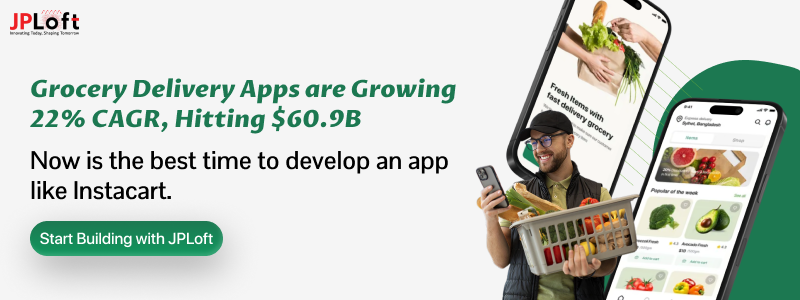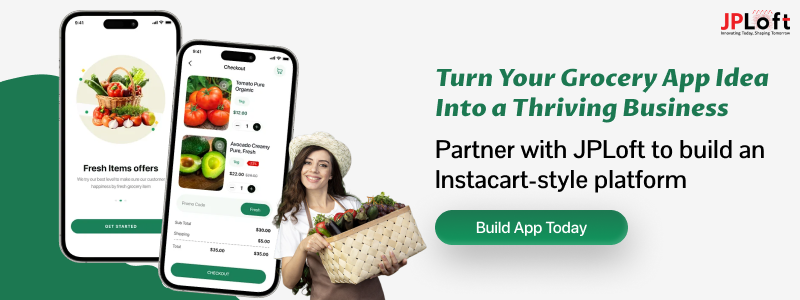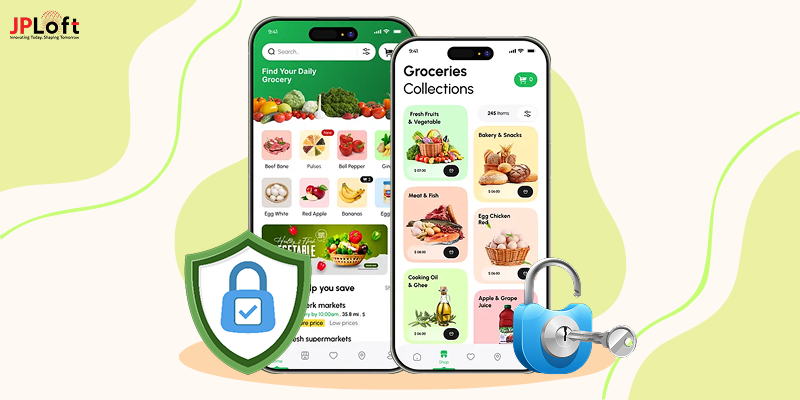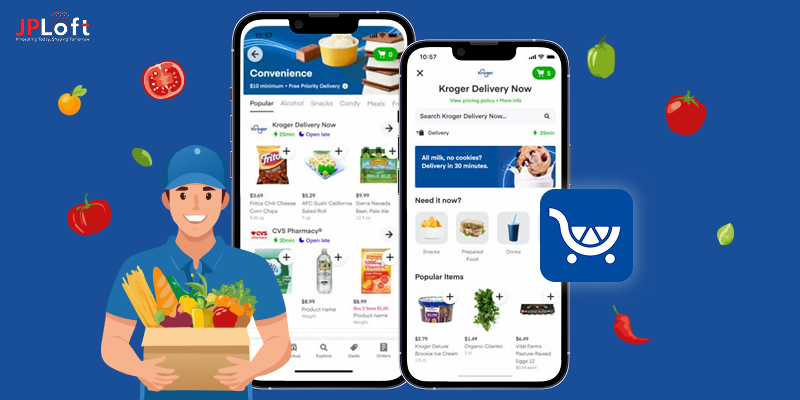Key Takeaways
The global online grocery delivery market is expanding rapidly, with projected revenue close to USD 939 billion in 2025.
An app like Instacart operates four distinct panels: customer app, shopper/delivery app, admin panel, and store partner panel.
Core features include user registration, real-time inventory sync, secure payments, order tracking, suggestions, and flexible delivery scheduling.
Development involves market research, business planning, MVP features, choosing a tech stack, UI/UX design, integration, testing, launch, and marketing.
Development costs range from USD 40,000 for a basic MVP to over USD 250,000 for a full-featured enterprise-level app.
Partnering with JPLoft ensures the creation of a feature-rich, scalable, and user-friendly grocery delivery app like Instacart.
In this digital-first world, Instacart app-like development is transforming how people shop for their everyday essentials. Users now enjoy the convenience of browsing a vast selection of products from multiple local stores, placing orders, and receiving their groceries at their doorstep, all with just a few taps on their smartphones.
Instacart has emerged as a leader in the grocery delivery market. Whether you are an entrepreneur looking to create a new business or a developer aiming to build a feature-rich, scalable app, the process of creating a grocery delivery app involves several crucial steps. And we are here to help you!
In this blog, we will guide you through how to develop an app like Instacart with the essential components, technologies, and strategies you need to consider when building a grocery delivery app like Instacart.
An Overview of Instacart: Get Food Delivery
Instacart is revolutionizing the way people get their groceries, offering a seamless and convenient food delivery experience. With just a few clicks on the app, users can shop from a vast selection of local grocery stores and have their orders delivered right to their doorstep. To create a grocery delivery app like Instacart, the company leveraged advanced AI-powered features like Smart Shop, which personalizes the shopping experience, helping customers find the most relevant items quickly.
Instacart provides flexible delivery options, including same-day delivery and scheduled slots, catering to users’ busy lifestyles. It also supports multiple payment gateways for a secure checkout, making grocery shopping hassle-free. Instacart further enhances the experience with detailed nutritional information and health tags, helping customers make informed and healthier choices.
Here are key statistics for grocery delivery apps and the online grocery market in 2025:
-
According to Statista, the global grocery delivery market revenue is projected to reach approximately USD 939 billion in 2025, with an annual growth rate of 9.7% through 2030.
-
Globally, the online grocery delivery service market is estimated by GII Research to surpass USD 1,100 billion by 2029 with a CAGR of 23.1%
-
Around 67% of consumers in urban areas now shop for groceries online, and online grocery orders grew by 22% in 2025, according to SayOneTech.
-
According to SaleHoo, Instacart holds a dominant 21.6% market share of the U.S. online grocery market in 2025, consistently maintaining this position since 2022.
If you make an app like Instacart, focus on innovative technology and a customer-centric approach to make it the top choice for efficient, reliable grocery delivery. Let’s explore how to develop a grocery delivery app like Instacart and bring your grocery delivery app idea to life.
Why Create an App Like Instacart?
Creating a grocery delivery app like Instacart can be a game-changing business idea for any startup, as it gives exposure to the booming on-demand economy and addresses one of the most consistent consumer needs: grocery shopping. Here are the key reasons why businesses and entrepreneurs should consider to develop a Instacart clone:
1. Growing Demand for Online Grocery Delivery
The global online grocery market is experiencing exponential growth and is estimated by Statista to reach USD 938.98 billion in 2025, driven by busy lifestyles, urbanization, and the rising adoption of digital services. Customers now prefer time-saving grocery delivery solutions, making such apps relevant.
2. High Revenue Potential
Apps like Instacart earn through multiple channels, such as delivery fees, service charges, subscription models, in-app advertising, and partnerships with grocery stores. This diversification ensures a steady revenue stream.
3. Scalability Across Regions
Once you create an app like Instacart by hiring dedicated developers, you can easily expand to new cities or countries by partnering with local stores. The model is highly scalable with relatively low infrastructure costs compared to traditional retail businesses.
4. Customer Convenience and Loyalty
By allowing customers to order groceries from their preferred stores and have them delivered quickly, such apps solve pain points like long queues, heavy lifting, and time constraints. Features like real-time tracking, scheduled deliveries, and personalized recommendations boost customer loyalty.
5. Support for Local Retailers
Build a Instacart clone to help small and medium grocery stores go digital, reach a wider audience, and compete with supermarkets. This makes your business appealing not just to consumers but also to store owners.
6. Technological Advantage
Build an AI app provides opportunities to leverage AI, data analytics, and machine learning for personalized shopping, predictive inventory management, and targeted marketing. This enhances both user experience and business efficiency.
7. Future-Proof Business
Consumer habits are shifting permanently towards online shopping, especially for groceries. Grocery delivery apps are no longer just a convenience but a necessity, making them a long-term profitable investment with strong market demand.
Creating an app like Instacart helps you get access to the growing market of online grocery delivery services. Defining how to build an app like Instacart that diversifies revenue streams, empowers local retailers, and provides unmatched convenience to customers, all while building a scalable and future-ready business.
Now that we've explored the key reasons why building an app like Instacart can be a game-changer for your business, let's dive into the mechanics behind how such an app operates.
How Does an App Like Instacart Work?
To develop an Instacart clone, focus on connecting customers with personal shoppers who pick up groceries from local stores and deliver them to the customer’s doorstep, making online grocery shopping fast and convenient.
Partner up with an experienced mobile app development company to get started with the building process.
Step 1. Create Account and Set Location
Users download the app or visit the website, register an account, and provide their delivery address, which determines the local stores they can shop from.
Step 2. Choose Store and Shop Products
Customers select from available grocery stores, view real-time catalogs, use filters (category, brand, deals), and add products to their virtual shopping cart.
Step 3. Set Preferences and Checkout
Before checking out, users can specify product preferences, substitutes, and leave notes for the shopper. Choose a delivery or pickup slot. Enter payment details and finalize the order with secure payment.
Step 4. Order Assignment and Personal Shopping
The platform assigns a personal shopper, who receives the order, shops for the items in-store, and may communicate with the customer in real time for any issues (substitutions or clarifications).
Step 5. Delivery or Pickup
For delivery: The personal shopper delivers the groceries directly to the customer.
For pickup: The shopper prepares the order for the customer to pick up at the store or curbside.
Step 6. Notifications and Support
Customers receive real-time updates and notifications about order status, shopper communication, out-of-stock changes, and fulfilled orders. Support is available for issues or refunds as needed.
Overall, creating an app like Instacart simplifies grocery shopping by leveraging technology, local stores, and a network of personal shoppers for fast, flexible, and user-friendly service.
After we've broken down how an app like Instacart functions behind the scenes. Let's take a closer look at the essential features that will make your app not only functional but also stand out in the competitive market.
Features to Include in an App Like Instacart
When building an app like Instacart, the grocery delivery app features you include will directly impact user experience, efficiency, and scalability. Since Instacart operates on a multi-sided marketplace model (customers, shoppers/delivery agents, and store partners), you will need to think about features for three different panels.
Table for Core Features of an Instacart-like App:
|
Component |
Features |
Description |
|
Customer App Features |
User Registration & Profiles |
Quick sign-up via email, phone, or social media. |
|
Search & Browse Products |
Smart filters, categories, and store-based browsing. |
|
|
Personalized Recommendations |
AI-driven suggestions based on shopping history. |
|
|
Real-Time Inventory |
Sync with store databases to show product availability. |
|
|
Shopping Cart & Wishlist |
Easy cart management and saved items for later. |
|
|
Multiple Payment Options |
Credit/debit cards, wallets, UPI, COD, etc. |
|
|
Real-Time Order Tracking |
Track shopper’s progress (shopping + delivery). |
|
|
Delivery Scheduling |
Choose same-day, next-day, or scheduled delivery slots. |
|
|
Substitution Preferences |
Customers can allow, reject, or choose product substitutes. |
|
|
Push Notifications & Alerts |
Updates for offers, order confirmation, delivery status. |
|
|
Ratings & Reviews |
Feedback for stores, products, and shoppers. |
|
|
Loyalty Programs & Discounts |
Coupons, memberships (like Instacart Express). |
|
|
Shopper/Delivery Agent App Features |
Easy Sign-Up & Verification |
Background checks and approval process. |
|
Order Management |
Accept/reject orders, view shopping list, update status. |
|
|
Navigation & Route Optimization |
Integrated Google Maps/Waze for efficient delivery. |
|
|
Barcode Scanning |
For quick product identification and price verification. |
|
|
In-App Chat/Call |
Communicate with customers for substitutions or clarifications. |
|
|
Earnings Dashboard |
Track completed orders, payouts, tips. |
|
|
Availability Toggle |
Go online/offline anytime. |
|
|
Ratings & Reviews |
Receive customer feedback to maintain quality. |
|
|
Store Partner Panel |
Store Profile Management |
Add/update store info, logos, hours, etc. |
|
Product & Inventory Management |
Upload products, update stock, prices, offers. |
|
|
Order Notifications |
Real-time alerts for new orders. |
|
|
Sales Analytics Dashboard |
Track revenue, popular items, customer behavior. |
|
|
Promotions & Discounts |
Set store-specific offers to attract more buyers. |
|
|
Admin Panel |
User & Store Management |
Approve/reject customers, stores, and shoppers. |
|
Order & Delivery Tracking |
Monitor ongoing and past orders. |
|
|
Commission & Payment Management |
Handle transactions, payouts, and fees. |
|
|
Analytics & Reporting |
Business insights, revenue reports, and churn analysis. |
|
|
Marketing & Promotions |
Push offers, referral programs, and featured listings. |
|
|
Dispute Resolution System |
Manage complaints, refunds, and replacements. |
Overall, if you plan to make an app like Instacart, it should target balancing simplicity for customers, efficiency for shoppers, assistance for delivery partners, and visibility for stores, while giving admins full control.
With a clear understanding of the must-have features for an app like Instacart. It's time to shift focus to the development process itself, exploring the steps and strategies needed to bring your vision to life.
How to Develop an App Like Instacart?
To create an app like Instacart requires a structured development process that balances business strategy, technology choices, and customer experience. Below is the step by step guide to develop an app like Instacart successfully:
Step 1. Market Research and Business Planning
Identify your target market, like specific regions/crowds, and study your competitors. Define your unique selling proposition (USP): cheaper delivery, faster times, niche stores, or eco-friendly options. Decide on your business model and focus on local organic produce delivery in your city at the initial stage.
Step 2. Define Core Features and MVP Scope
List all features you want, but prioritize MVP (Minimum Viable Product) features first:
-
Customer App: registration, product browsing, cart, payments, order tracking.
-
Shopper App: order management, navigation, earnings tracking.
-
Store Panel: inventory management, order updates.
-
Admin Dashboard: analytics, commission management, and user control.
-
Advanced features: AI recommendations, AR shopping, and loyalty programs, which can be added later after launch.
Step 3. Choose the Right Tech Stack
The choice of the right mobile app tech stack affects scalability, performance, and cost.
-
Frontend: Flutter, React Native (cross-platform), or Native iOS (Swift), Android (Kotlin).
-
Backend: Node.js, Django (Python), Ruby on Rails, or Java Spring Boot.
-
Database: PostgreSQL, MySQL, MongoDB.
-
APIs & Integrations:
-
-
-
-
Maps & navigation: Google Maps, Mapbox.
-
Payments: Stripe, Razorpay, PayPal, Braintree.
-
Push notifications: Firebase, OneSignal.
-
Cloud Hosting: AWS, Google Cloud, Azure.
-
-
-
-
Step 4. Design UI/UX
Create wireframes and mockups for each user panel. Focus on ease of navigation, as grocery apps must be simple, not cluttered. Add features like product images, filters, and substitution options. Ensure simple mobile app design with smooth accessibility (large fonts, voice search, and color-blind friendly).
Step 5. Build Grocery Retailer Network
Follow the guide to create an app like Instacart and partner with grocery stores, retailers, and suppliers to ensure product variety, real-time inventory updates, and that align with the target market.
Step 6. Development Phase
Partner with an on-demand app development company and include core features like registration, product search, cart, checkout, payment integration, delivery scheduling, and order tracking. Build out three panels: customer app, delivery/shopper app, and admin dashboard for management and analytics.
Step 7. Integrate Payments, Notifications, and Security
Add secure payment gateways (Stripe, Razorpay, PayPal). Set up real-time notifications via SMS, email, or in-app alerts using APIs (Firebase, Twilio). Follow agile methodology: develop in sprints, test mobile app security continuously, and release features in iterations.
Step 8. Testing and Quality Assurance (QA)
Test thoroughly for bugs, edge cases, and device compatibility, both manually and with automated scripts. Confirm smooth performance under real-world conditions with functional mobile app testing, performance testing, usability testing, and security testing.
Step 9. Launch and Development
Deploy the backend on the cloud (AWS, GCP, or Azure). Publish apps on the Google Play Store and Apple App Store. Run a soft launch in one city or region before expanding. A regional launch helps fix issues early without risking your full brand reputation.
Step 10. Marketing and Customer Acquisition
Run referral programs to retain new customers. Partner with local grocery stores for promotions. Use social media ads, influencer campaigns, and local SEO. Offer discounts on the first few deliveries to attract users. Without aggressive marketing, even the best-built app won’t succeed.
Step 11. Post-Launch Support and Maintenance
Monitor performance, uptime, and customer feedback. Provide 24/7 customer support for order issues. Regularly release updates, bug fixes, and new features. Scale servers and infrastructure as the user base grows. Plan for 15–20% of development cost yearly for updates and mobile app maintenance services.
Step 12. Scale and Expand
Hire dedicated developers to add premium subscriptions or membership plans to your app. Partner with more stores & brands for ad revenue. Introduce white-label delivery solutions for other retailers. Expand to new regions or countries once stable.
By following these development steps for an app like Instacart, your app development starts lean and grows iteratively. Your business enters the grocery delivery market without overspending while positioning your grocery delivery app for long-term growth.
Let's now explore what's the cost to create an app like Instacart and the factors that influence building such an app.
Cost to Build an App Like Instacart
Building an app like Instacart requires careful planning, technology choices, and investment. The cost to develop an app like Instacart can range from USD 40,000 for a basic MVP to USD 250,000+ for an enterprise-level app. The exact budget depends on your target market, feature set, and tech approach.
A] Estimated Cost Breakdown by App Panels
Below, we have made a table for the cost breakdown of Instacart-like app development:
|
App Components |
Estimated Cost Range (in USD) |
|
Customer App (iOS & Android) |
$25,000 – $50,000 |
|
Shopper/Delivery App |
$15,000 – $30,000 |
|
Store Partner Panel |
$10,000 – $20,000 |
|
Admin Dashboard |
$15,000 – $25,000 |
|
Backend & APIs |
$20,000 – $40,000 |
|
UI/UX Design |
$8,000 – $15,000 |
|
Testing & QA |
$5,000 – $10,000 |
|
Maintenance (Yearly) |
~15–20% of total cost |
B] Estimated Total Instacart-like App Development Cost
Let's look at the total development cost of an app like Instacart, depending on the features and complexity level:
► Basic MVP (Minimum Viable Product)
-
Estimated total development cost (in USD): $40,000 – $60,000
-
Includes core features: Product browsing, cart, payments, and basic delivery tracking.
-
Development Time: 2-3 months
► Mid-Level App
-
Estimated total development cost (in USD): $70,000 – $120,000
-
Includes core features: Adds real-time tracking, multi-store integration, loyalty programs, and AI-powered recommendations.
-
Development Time: 7-9 months
► Full-Scale Instacart Clone
-
Estimated total development cost (in USD): $150,000 – $250,000+
-
Includes core features: Enterprise-level with advanced AI, AR shopping, multi-region scaling, white-label solutions, and full automation.
-
Development Time: 11 months+
C] Ongoing Costs After App Development
Beyond initial development, you must also budget for:
-
Cloud Hosting and Servers: $1,000 – $5,000/month
-
Maintenance and Updates: 15–20% of annual dev cost
-
Marketing and User Acquisition: $10,000 – $50,000/month (depending on region & scale)
-
Customer Support and Operations: Salaries for support staff, shopper training, etc.
D] Advanced Features: An Add-On Development Cost
Below is a list of advanced features that, when integrated into the process to make an app like Instacart, can improve the user experience and operations, but will add up as additional development costs:
-
Voice Search & Smart Assistants: Voice command recognition in the app for adding items to the cart.
-
AI-Based Personal Shopper: Personalized weekly grocery lists.
-
AR-Based Product View: See nutritional info by scanning packaging.
-
Multi-Delivery Options: Express delivery (1–2 hours), scheduled, or curbside pickup.
Sustainability Filters: Eco-friendly or organic product tagging.
The cost to develop such an app depends on several factors, including features, tech stack, design complexity, and the development team’s location. Investing more typically results in a robust, scalable, and competitive app capable of handling high user demand.
Now, it's time to shift focus to how such an app generates revenue. Understanding the monetization strategies to integrate while you create a grocery delivery app like Instacart that will generate potential return on investment.
How does an App Like Instacart Make Money?
An app like Instacart runs on a multi-revenue stream model, which allows it to generate income from customers, partner stores, and delivery services. This diversified approach ensures steady earnings and long-term scalability. Let's break down these Grocery Delivery App Monetization Models used by an app like Instacart:
1. Delivery Fees
Customers pay a fee for each order placed through the app. The fee varies depending on the order size, time slot, peak surge hours, and urgency (express delivery costs more). This is one of the primary sources of revenue, as every customer contributes to it.
2. Service Fees
A small percentage-based fee is added to every order. Covers operational expenses like payment processing, customer support, and technology upkeep. Even a small percentage becomes significant with high transaction volumes.
3. Markup on Products
Sometimes, products on the app cost slightly more than in-store prices. The extra margin goes to the platform as revenue. For stores not officially partnered with apps like Instacart, this markup helps the platform cover sourcing costs.
4. Membership/Subscription Plans
Create a grocery delivery like Instacart that offers a premium plan, where customers pay a monthly or yearly fee. Benefits include free deliveries on orders above a minimum value, reduced service fees, and exclusive offers. Subscriptions provide recurring revenue and improve customer loyalty.
5. Commissions from Partner Stores
Grocery stores and supermarkets pay Instacart a commission for each order placed through the app. Stores benefit from increased visibility, customer reach, and sales. This attracts small and mid-sized retailers who want to compete with larger chains.
6. In-App Advertising and Promotions
Brands and grocery stores pay for featured placements, sponsored listings, and banner ads. These ads are targeted using customer shopping history, making them very effective. With millions of users, this becomes a lucrative revenue stream.
7. Tips from Customer
Customers tip delivery agents, and while this goes directly to shoppers, develop a grocery delivery app like Instacart that sometimes charges transaction processing fees. Indirectly, tips improve shopper satisfaction and retention, keeping the business running smoothly.
This multi-layered model ensures various revenue flows, making such apps both profitable and scalable, and encouraging entrepreneurs to build a Instacart clone for long-term business success.
Partner with JPLoft and Create an App Like Instacart
If you are ready to tap into the booming on-demand grocery delivery market, partnering with JPLoft can turn your vision into reality. With years of expertise in on-demand app development, we specialize in building scalable, feature-rich, and user-friendly grocery delivery platforms tailored to your unique business needs.
At JPLoft, we go beyond just coding; we craft a robust model, design a seamless user experience, and integrate recently launched advanced features that give your app a competitive edge. Our developers leverage the latest technologies, APIs, and cloud solutions to create apps that are secure, fast, and scalable. We also provide post-launch support, maintenance, and upgrades.
Your hunt for a reliable expert grocery delivery app development company ends here! Choose JPLoft, and together let’s build a grocery delivery app that redefines convenience and drives long-term success.
Conclusion
Developing an app like Instacart is not just about replicating a grocery delivery model but about creating a customer-centric, scalable, and future-ready solution. With shifting customer habits and rising demand for convenience, grocery delivery apps have moved from being a luxury to an everyday necessity.
The success of such apps depends on balancing simplicity for customers, efficiency for shoppers, and profitability for stores, while ensuring the backend is strong enough to handle the growth. Starting with a clear business model, launching a well-designed MVP, and continuously improving through customer feedback can significantly reduce risks and costs.
Ultimately, a grocery delivery app like Instacart offers a long-term business opportunity that benefits everyone: customers, retailers, and delivery partners. While building a sustainable revenue stream for entrepreneurs who invest strategically.
FAQs
To develop an app like Instacart, start with market research, define your business model, and plan core features for customers, shoppers, and stores. Choose a scalable tech stack, design an intuitive UI/UX, build and test an MVP, launch regionally, gather feedback, and scale with advanced features and marketing
The cost can range from USD 40,000 to USD 250,000+, depending on features, design, technology stack, and the development team’s location. An MVP version is cheaper, while a full-scale app requires a higher investment.
These types of grocery delivery apps earn through multiple business models. Some of them are delivery fees, service charges, product markups, subscriptions, store commissions, and in-app advertising from brands and retailers.
Depending on the complexity of the app development, the number of features integrated, testing, and platforms chosen (iOS, Android, or web), it takes 3–11 months on average to build a functional launchable grocery delivery app.
Yes. A complete grocery delivery ecosystem includes customer apps, shopper/delivery apps, store panels, and an admin dashboard that has access to manage all these apps and operations efficiently.













Share this blog